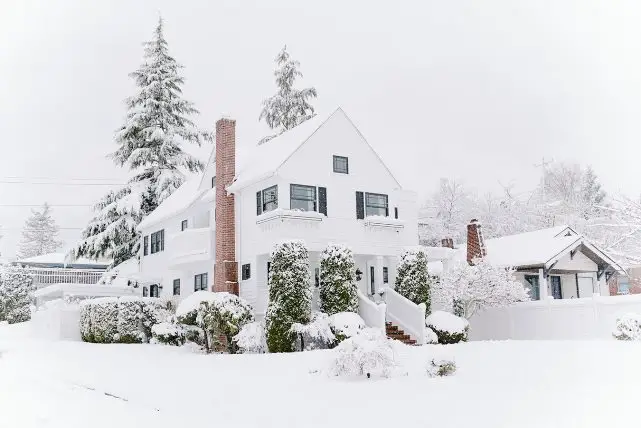
Heating costs can be a serious concern for many elders living in climates like in the northern U.S. where the winters are just plain cold. Such a concern that paying for heat can sometimes compete with buying groceries. This is especially true with older homes, which can be drafty and hard to heat without considerable cost. So conserving energy costs during the heating season is of crucial importance.
Do you ever hear a tap or a creak that seems to come from nowhere, and tell yourself, “It’s just the house settling”? Well, take an old farmhouse built in the 30s, and think about all the time in between then and now. That’s a lot of ‘settling.’
Due to the nature of gravity, weather, wear and tear on building materials, and other environmental concerns, an older house can develop gaps around windows and doors that were originally tight, and cracks and crevices in floors and ceilings that can allow heat to escape and cold to enter. Add to that the sometimes exorbitant cost of heating oil, electricity, or natural gas, and all the other factors contributing to heating costs in older homes, and you have an expensive and stressful winter season. So what’s to be done?
As winter approaches, when the temperature takes a dip, an obvious solution is to crank up the thermostat, but that inevitably leads to higher costs, and if you’re like a lot of American seniors, you have a limited budget to put toward keeping your house warm.
Elderly homeowners can turn to their home warranty company to help cover the costs of repairs to their heating systems if the system itself needs repair, but not everyone carries these warranties.
So what are the alternatives? We’ve done the research — entire books have been written on the subject — and we’ve talked to seniors we know who battle the draftiness of their houses every winter, and we’ve nailed down a few ways to stay warm in your home while lowering power costs. So before you dial up the thermostat or plug in that space heater, here are ten affordable ways to keep your house warm this — and every — winter. (For more information, see our article on winter tips for seniors.)
1. Use Curtains to Insulate Window Areas
Installing good quality curtains and/or thermal blinds is an effective way to prevent your house from losing heat through the windows, where most of the drafts are. Curtains function as a layer of protection and will help keep your house warm in the winter. Make sure you open up your curtains during the day, to let the warmth of the sunlight into your home. You’d be surprised how much natural heat comes from simple sunlight. Then, when the sun goes down, draw the blinds to add insulation and trap the warmth of the day inside. This is a popular and well-documented heat-conservation strategy.
2. Cover Your Windows with Plastic
This might be considered a “backwoods” trick, and you will partially lose the view out your windows, but tacking clear plastic sheeting around the inside of your window frames prevents drafts in a major way. The sheeting is available at home improvement stores or on Amazon. It’s translucent enough to let in light, and thick enough to stop cold air from entering through gaps in the window frame. Then, in spring, remove the sheeting, enjoy the view and the natural warmth of the sun, and put the plastic away where it will be accessible the following season.
3. Add Rugs
Everybody knows the feeling of waking up and putting your feet on the floor only to experience a shocking chill from the hardwood, concrete, or tile. Covering your floors will prevent this unpleasant sensation, and it will mitigate heat loss. Conventional wisdom has it that insulation against the cold was one of the reasons rugs and carpets were invented in ancient times. And they still do the job today. Providing your floors with insulation helps to trap the heat inside your home, increasing comfort and cutting down on energy costs. Your feet will feel much warmer!
4. Use Residual Heat
Leaving the bathroom door open after a hot shower will let all the heat from the steam into your living areas. Similarly, keeping the oven door open after you’ve finished baking is another handy trick to increase residual heat, simultaneously making your kitchen smell like home. Making yourself a cup of hot coffee or tea will also warm you up, and if you leave the lid of your kettle open, that little bit of heat will travel through the house, making a small but noticeable difference.
5. Seal Off Unused Areas
This begins with closing the doors in any unused room, thereby reducing the size of the area you need to heat. And if you go one step further and actually “move in” to a smaller area of your home — putting your bed in the living room and closing off the bedroom, for example —it will be easier to keep your living space warm and prevent any heat from escaping into unused rooms. And since it takes less energy to warm up a smaller area, you’ll see savings on your heating bill.
6. Radiator Panels
Make sure the heat from your radiator is used to keep your room warm rather than the walls. Installing radiator panels solves the problem by reflecting heat into your living space and preventing it from escaping through the walls. The material for making your reflector shield is available for sale, and aluminum foil also works, if you want to do it yourself. The idea is to make your radiator heater more efficient, thereby saving you money and making your rooms cozy.

7. Use Throws and Blankets
Everybody loves to hang out in the living room to watch a movie or catch up with friends and family. It’s these times when we’re sitting and not moving around that our circulation slows down, and we’re more susceptible to cold. But that doesn’t mean you have to turn up the thermostat. Instead, wrap yourself up with a warm blanket. You can even slip a hot water bottle under your blanket for extra heat as you enjoy company and conversation.
8. Install a Programmable Thermostat
These handy little devices serve a simple function: they turn the heat down automatically at a time you determine, like bedtime when you’ll be under the covers, and turn it back up in the morning. For example, you could program your thermostat to keep the temperature a steady 70 degrees throughout the day, and 60 overnight. This elimination of energy waste will knock a chunk out of your heating bill. The Honeywell Home RTH is a thermostat favored by many.
9. Bring Down Heat with a Ceiling Fan
Fans are for cooling, right? Not always. Especially in a room with high ceilings, where heat rises and gathers overhead instead of circulating through the area, a ceiling fan can be used on the lowest setting to point the warmer air downward. Just make sure you flip the switch on the side of the fan to reverse its direction if necessary. You’ll notice that the high-ceilinged room no longer feels chilly and unwelcoming. And, just as with the other tips we’ve discussed, your heating bill will be significantly lower.
10. Clear Space Around Your Heating Unit
Is your register, radiator, or vent located behind a piece of furniture like a bed or sofa? If so, you’re spending a lot of energy heating air that only gets blocked. To make sure the warmth circulates throughout the room, study your space and come up with a better arrangement of furniture. You’ll feel the difference, and hey, who doesn’t like to mix up the feng shui from time to time?
Closing Thoughts
No one likes the cold, but what’s worse is receiving a huge power bill in the mail. Use these ten tips to warm up your old house. Think of them as weapons in an arsenal you have against the chill of winter. And as always, if you have a tip of your own that people need to know about, tell us about it in the comment section below. Here’s to heat and happiness!


1 comment
Thanks for the helpful advice! I just want to add that if you get your hot water from a hot water storage tank, you also need to insulate it. Insulation with an R-value of at least 24 is preferable. This could reduce heat loss by up to 45% and save you around 10% in water heating costs.
The good news: you can find pre-cut water tank insulation jackets from around $20